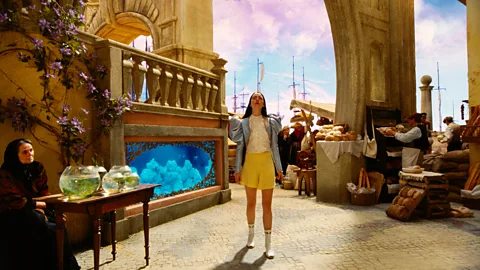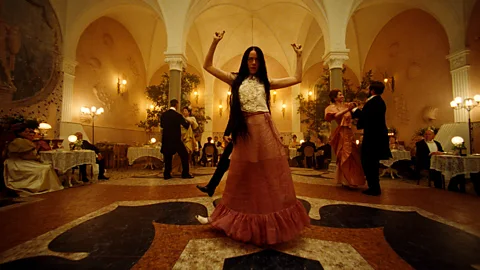Best costumes Oscar winner talks about Poor Things and Emma Stone's 'Bella Style'
 Atsushi Nishijima
Atsushi NishijimaOscar-winning designer Holly Waddington explains the hidden meanings behind Emma Stone's 'Bella Style' – from sexual awakening to joyful empowerment.
Finding the right costumes is vital to make a film sing; but rarely are costumes so key to character as they are in Yorgos Lanthimos's film Poor Things, a riff on the Frankenstein story. The work of Holly Waddington, who has just won this year's Oscar for best costume design, they are fundamental to the surreal world in which the film is set, as well as being essential to the characterisation of the protagonist, Bella Baxter, played by Emma Stone – who won the best actress Oscar for the role.
This article contains spoilers for the plot of Poor Things
Rarely in film do characters go through such a gamut of looks. But then, rarely do characters travel from grown woman to toddler to grown woman again all in two hours and 21 minutes. The costumes match Bella, played with abandon by Emma Stone, step for step, beating a frenetic path from infant to fully grown via babydoll dresses, joyful, frothy ruffles, enormous sleeves and forgotten or discarded tros, before moving into sensible, protective coats and more serious medical-student monochrome.
 Searchlight Pictures
Searchlight Pictures"Her style is a reflection of where she's at in her development," Waddington tells BBC Culture of what she has called "Bella style", an aesthetic that has also won her a Bafta. "That was what was driving the looks." The result has been called "Age of Innocence meets surrealism meets couture", or Victorian steampunk, and provides a visual narrative through which to understand Bella's character.
Let's start at the end. When Bella, a woman who has arrived back at adulthood, concludes her character arc, she sits contentedly in the freshly unshackled world she has finally been able to craft for herself. It is a darkly utopian scene. She wants to be a doctor and is reading a medical text. Her abusive ex-husband has had the brain of a goat transplanted into his body, and he is grazing and occasionally bleating on the lawn.
She is wearing a knitted cream rollneck and culottes the colour of tobacco. It is an outfit befitting of this brave new world in which she now sits, studying and drinking gin. Grownup and understated, but still with some flair in the sleeve – Bella Baxter, even fully-fledged, is not going to wear an unremarkable sleeve. It could not be further from the outfits that have gone before – gone are the frills of Bella's earlier costumes, gone are the frothy fabrics, gone are the pastels – and speaks volumes about the journey that Bella goes on throughout the film.
 Searchlight Pictures
Searchlight PicturesWhen we first meet Bella, she has been reanimated by Willem Defoe's unhinged scientist Godwin, her adult brain replaced by the brain of her unborn foetus. The costumes fit her new reality: all babyish quilting, ruffles and seersucker, Bella is often barefoot, and wearing just her knickers on her bottom half, top heavy in frothy silhouettes. She is often partially dressed. "If you properly dress a young child for a wedding or a party, they don't stay intact for very long and very quickly they unravel," says Waddington of her thinking. In the early scenes of the film, Bella's character has been dressed by the housemaid, Mrs Prym, but "by mid-morning bits would come off because of the nature of her play".
As Bella's mind grows, her costumes shift. Heading out into the world in the next chapter of the film, and on a trip to Lisbon with the caddish man-baby Duncan Wedderburn, played by Mark Ruffalo, Bella is dressing herself for the first time. The result is devil-may-care and thrilling. A walk around Lisbon, to gorge on pastel de nata and the world at large, sees her wearing a blue jacket and silky, custard-yellow shorts.
More like this:
With no Mrs Prym to dress her, "top bits are left on… and the bottom bit, she's still in the pants but she's forgotten the skirt," says Waddington. "I was trying to catch something of the discordancy that you get when children dress up in a grown-up's clothes." She was inspired by pictures of herself and her sister dres as children: "there's this chaos to it, kind of lovely, feels a bit wrong, and I was trying to create something of that."
 Searchlight Pictures
Searchlight PicturesThat chimes with Deborah Jermyn, a reader in film and television at Roehampton University. "She doesn't have the guidance from inside the oppressive domestic space that she's been in with a housekeeper and this very patriarchal figure, and it gets really playful, eccentric."
Organic and bodily
Her burgeoning, blossoming sexuality is expressed via visceral costumes exploding with pink frothy ruffles, one was given the on-set moniker the "clitoris blouse", another the "vagina blouse". Waddington wanted everything to feel organic and bodily, but not in a "sexy" way, rather inspired by body parts, lungs and organs and intended to give a "sense of the living and the breathing of the body, referencing the textures that are within the human body, so you know the frills of tripe or the sponginess of fat or the smoothness of liver", but also shells, coral and other sea creatures.
As Bella enters the stage of the film set in a brothel, her costumes divert for a moment from visceral and textured to conservatively wrapped up – the so-called "condom coat" seems the perfect outerwear for her arrival at a point where she plans to use her body for exploration and commerce, but not procreation. It is, says Jermyn, "one of those moments where you have to sit up and say 'what's she come out with now, where's this come from">window._taboola = window._taboola || []; _taboola.push({ mode: 'alternating-thumbnails-a', container: 'taboola-below-article', placement: 'Below Article', target_type: 'mix' });
